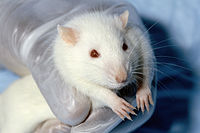
Photo from wikipedia
The authentication of animal species is an important issue due to an increasing trend of adulteration and mislabeling of animal species in processed meat products. Polymerase chain reaction is the… Click to show full abstract
The authentication of animal species is an important issue due to an increasing trend of adulteration and mislabeling of animal species in processed meat products. Polymerase chain reaction is the most sensitive and specific technique for nucleic acid-based animal species detection. However, it is a time-consuming technique that requires costly thermocyclers and sophisticated labs. In recent times, there is a need of on-site detection by point-of-care (POC) testing methods and devices under low-resource settings. These POC devices must be affordable, sensitive, specific, user-friendly, rapid and robust, equipment free, and delivered to the end users. POC devices should also confirm the concept of micro total analysis system. This review discusses POC testing methods and devices that have been developed for meat species identification. Recent developments in lateral flow assay-based devices for the identification of animal species in meat products are also reviewed. Advancements in increasing the efficiency of lateral flow detection are also discussed.
Journal Title: Comprehensive reviews in food science and food safety
Year Published: 2021
Link to full text (if available)
Share on Social Media: Sign Up to like & get
recommendations!